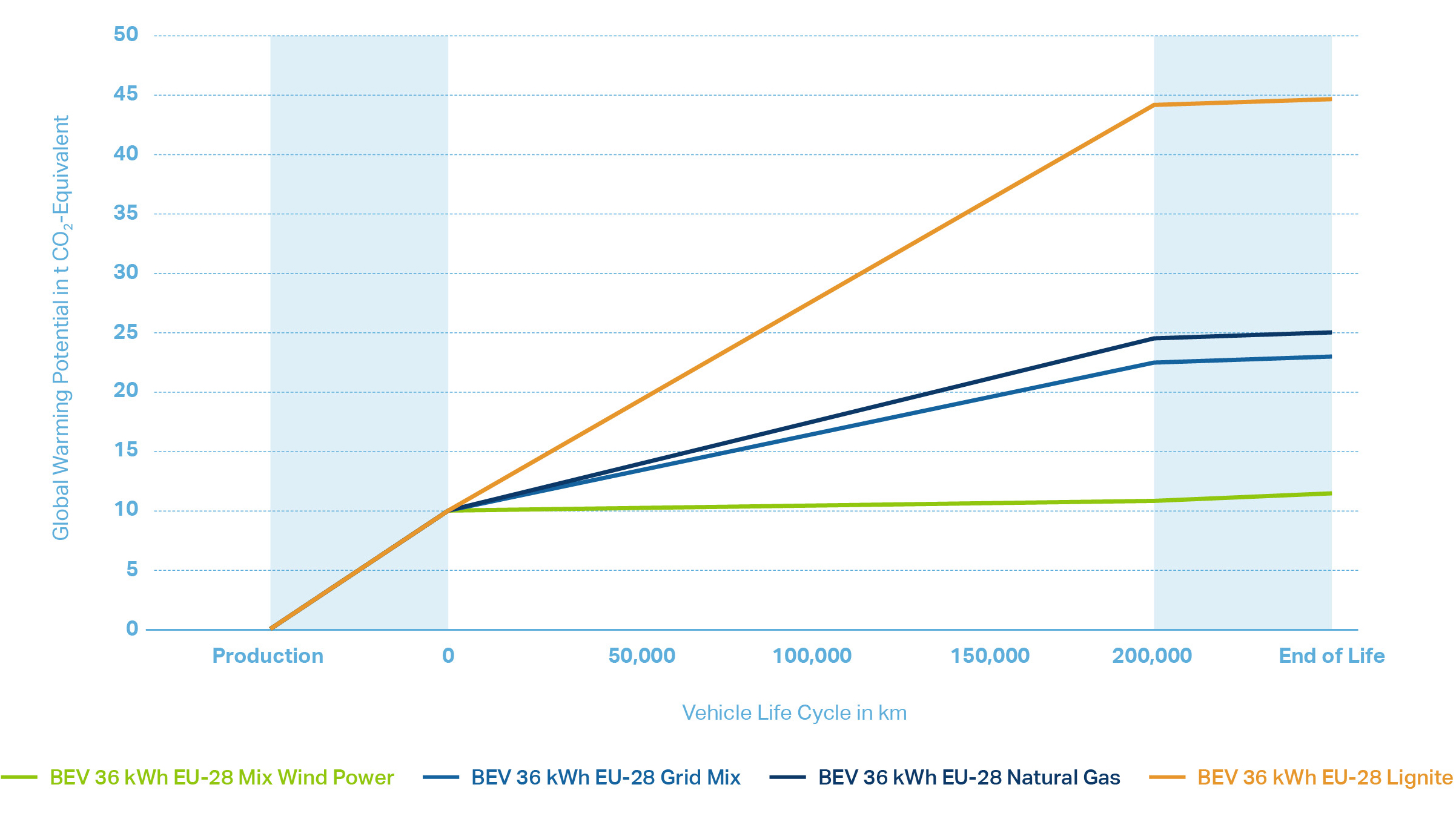How the electricity mix affects the ecological footprint of e-cars
In our first article we asked a little flatly, if it always has to be the biggest battery. In this post, we want to discuss why it might make ecological sense to include a slightly larger battery in the vehicle.
Let us first return to our graph of greenhouse gas emissions over the life cycle. In the light blue line, we see the results for the electric vehicle as shown in our last article. The production of the electric vehicle accounts for approx. 10 t CO2-equivalents. Combined with the Green House Gas (GHG) emissions linked to electricity production during the use stage, the electric vehicle exhibits 23 t CO2-equivalents for the entire life cycle. The figure also depicts the GHG emissions of the life cycle using regenerative (wind power) and full fossil electricity (lignite and natural gas) in the use stage. Looking at the entire life cycle, the use of regenerative electricity from wind power offers a reduction potential of approx. 70 percent in GHG emissions compared with fossil electricity from lignite.

The question is: Which kind of electricity ends up in my car, and under which circumstances?
Let’s conduct the following thought experiment. On a beautiful sunny day, we drive with our electric vehicle to a station and connect it to charge. In that very moment, the wind freshens up on the North Sea coast and pushes electrons to southern Bavaria into the battery of our vehicle. Fantastic, but unfortunately, rather in the literal sense of the word. So where does the electricity come from? – In the best case, it is renewable energy from some form of storage power station. Alternatively, a gas or coal power plant is operated under higher load to provide the additional electricity. At present we lack possibilities to store electricity, hence it is more likely that we charge our vehicle with non-renewable electricity. This is especially true, if we need to charge the vehicle in a short period of time.
E-Cars bolster energy management
So, how do we manage to use as much renewable electricity as possible? The answer is, the electric vehicles themselves, their batteries, and the charging stations can help. An average vehicle is actually parked most of the day. If the vehicle is connected to a charging station during this time, it will no longer be necessary to always charge the vehicle if the plug is connected. Instead, the vehicle can be actively charged when sufficient renewable electricity is available. This process is known as grid-based or priority charging.
The capacity of the traction battery in a state-of-the-art vehicle exceeds the day-to-day requirements many times over. In other words, the vehicle only uses a small share of the energy stored in the battery on a typical day. The vehicle is therefore able to deliver electricity to other consumers while still meeting the usual customer requirements in terms of mobility. In essence, the vehicle can release previously stored regenerative energy and may even help improve the electricity grid mix. This concept is called Smart-Grid. If one imagines app. 60 million potential electric vehicle users in Germany who provide only 20 percent of an assumed average net capacity of 60 kWh per vehicle for Smart-Grid, this results in a buffer storage of 720 GWh for renewable electricity. Germany currently consumes around 1.400 GWh per day, i.e. the storage capacity provided corresponds to about half of Germany’s daily demand.
Fiction or reality?
Sounds too good to be true?
Some vehicles are already able to buffer electricity and pilot projects for Smart-Grid applications are being launched.
«The vehicle actively balances out load peaks in the power grid via the charging station in the company parking lot. Ideally, the vehicle earns some extra money while parking.»
In a world where Smart-Grid is implemented, we unplug our charged electric vehicle early in the morning, drive to the office with enough charge for the way to work and other typical trips and while we are busy at work, the vehicle actively balances out load peaks in the power grid via the charging station in the company parking lot. Ideally, the vehicle earns some extra money while parking. After work, we plug the vehicle in overnight and while we sleep – you probably already guessed it – the electric car earns money too.
From our point of view, V2G offers a considerable potential to store and use renewable generated electricity. A wide range of business models can also be developed using this methodology.
But constantly charging and discharging – won`t that harm the lifetime of our battery – see Smartphone?
This depends on the size of the battery, among other things. Larger traction batteries are more suitable for V2G applications, since more energy can be stored in the vehicle. The relationship between battery service life, capacity and number of cycles will be dealt with in one of the next articles.
But first we want to investigate where the immense carbon footprint of the battery actually comes from?
Are you aware of any Smart-Grid applications in place? What about business-models? We will be happy to receive your comments.
If you think this article is interesting for others in your network, feel free to share it.


